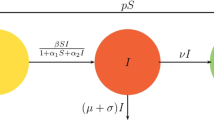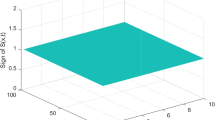Abstract
The purpose of this work is reviewing some reduction results to deal with systems of nonautonomous ordinary differential equations with two time scales. They could be included among the so-called approximate aggregation methods. The existence of different time scales in a system, together with some long-term features, are used to build up a simpler system governed by a lesser number of state variables. The asymptotic behavior of the latter system is then used to describe the asymptotic behaviour of the former one. The reduction results are stated in two particular but important cases: periodic systems and asymptotically autonomous systems. The reduction results are illustrated with the help of simple spatial SIS epidemic models including either periodic or asymptotically autonomous terms.



Similar content being viewed by others

References
Anderson RM, May RM (1991) Infectious diseases of humans: dynamics and control. Oxford University Press, Oxford
Arino J (2009) Diseases in metapopulations. In: Ma Z, Zhou Y, Wu J (eds) Modeling and dynamics of infectious diseases, series in contemporary applied mathematics, vol 11. World Scientific, Singapore, pp 65–123
Auger P (1989) Dynamics and thermodynamics in hierarchically organized systems. Pergamon Press, Oxford
Auger P, Bravo de la Parra R, Poggiale JC, Sánchez E, Nguyen Huu T (2008a) Aggregation of variables and applications to population dynamics. In: Magal P, Ruan S (eds) Structured population models in biology and epidemiology, lecture notes in mathematics, vol 1936. Springer, Berlin, pp 209–263
Auger P, Bravo de la Parra R, Poggiale JC, Sánchez E, Sanz L (2008b) Aggregation methods in dynamical systems and applications in population and community dynamics. Phys Life Rev 5:79–105
Auger P, Poggiale JC, Sánchez E (2012) A review on spatial aggregation methods involving several time scales. Ecol Complex 10:12–25
Auger P, Roussarie R (1994) Complex ecological models with simple dynamics: from individuals to populations. Acta Biotheor 42:111–136
Bravo de la Parra R, Marvá M, Sánchez E, Sanz L (2013) Reduction of discrete dynamical systems with applications to dynamics population models. Math Model Nat Phenom 8:107–129
Diekmann O, Heesterbeek H, Britton T (2013) Mathematical tools for understanding infectious disease dynamics. Princeton University Press, Princeton
Fenichel N (1971) Persistence and smoothness of invariant manifolds for flows. Indiana Univ Math J 21:193–226
Fenichel N (1979) Geometric singular perturbation theory for ordinary differential equations. J Differ Equ 31:53–98
Grassly NC, Fraser C (2006) Seasonal infectious disease epidemiology. Proc R Soc Lond B 273:2541–2550
Hethcote HW (1973) Asymptotic behaviour in a deterministic epidemic model. Bull Math Biol 35:607–614
Hethcote HW, Levin SA (1989) Periodicity in epidemiological models. In: Levin SA, Hallam TG, Gross LJ (eds) Applied mathematical ecology (Trieste, 1986), biomathematics, vol 18. Springer, Berlin, pp 193–211
Hoppensteadt F (1966) Singular perturbations on the infinite interval. Trans Am Math Soc 123:521–535
Hoppensteadt F (1971) Properties of solutions of ordinary differential equations with small parameters. Commun Pure Appl Math 34:807–840
Hoppensteadt F (1993) Analysis and simulation of chaotic systems. Springer, New York
Hoppensteadt F (2010) Quasi-static state analysis of differential, difference, integral, and gradient systems. New York University, Courant Institute of Mathematical Sciences, New York
Iwasa Y, Andreasen V, Levin S (1987) Aggregation in model ecosystems I: Perfect aggregation. Ecol Model 37:287–302
Iwasa Y, Levin S, Andreasen V (1989) Aggregation in model ecosystems. II. Approximate aggregation. J Math Appl Med Biol 6:1–23
Jones CKRT (1994) Geometric singular perturbation theory. In: Johnson R (ed) Dynamical systems, montecatini terme, lecture notes in mathematics, vol 1609. Springer, Berlin, pp 44–118
Kouokam E, Auger P, Hbid H, Tchuente M (2008) Effect of the number of patches in a multipatch SIRS model with fast migration on the basic reproduction rate. Acta Biotech 56:75–86
Li XJ, Wang K (2007) The survival analysis of a non-autonomous n-dimensional volterra mutualistic system in a polluted environment. Acta Math Appl Sin Engl Ser 23:133–140
Lofgren E, Fefferman NH, Naumov YN, Gorski J, Naumova EN (2007) Influenza seasonality: underlying causes and modeling theories. J Virol 81:5429–5436
Luckyanov NK, Svirezhev YM, Voronkova OV (1983) Aggregation of variables in simulation models of water ecosystems. Ecol Model 18:235–240
Martcheva M (2009) A non-autonomous multi-strain SIS epidemic model. J Biol Dyn 3:235–251
Markus L (1956) Asymptotically autonomous differential systems. Contributions to the theory of nonlinear oscillations III. In: Lefschetz S (ed) Annals of mathematics studies, 36th edn. Princeton University Press, Princeton, pp 17–29
Marvá M, Bravo de la Parra R, Auger P (2012a) Reproductive numbers for nonautonomous periodic two time scales spatially distributed SIS. Acta Biotech 60:139–154
Marvá M, Bravo de la Parra R, Poggiale JC (2012b) Approximate aggregation of a two time scales periodic multi-strain SIS epidemic model: a patchy environment with fast migrations. Ecol Complex 10:34–41
Marvá M, Poggiale JC, Bravo de la Parra R (2012c) Reduction of slow–fast periodic systems: fast migrations in a predator-prey community. Math Model Method Appl Sci 22:1250025. doi:10.1142/s021820251250025x
Marvá M, Bravo de la Parra R, Poggiale JC (2013) Reduction of slow–fast asymptotically autonomous systems with applications to gradostat models. Ecol Complex 14:75–84
Mischaikow K, Smith HL, Thieme HR (1995) Asymptotically autonomous semiflows: chain recurrence and Lyapunov functions. Trans Am Math Soc 347:1669–1685
Noethen L, Walcher S (2009) Quasi-steady state and nearly invariant sets. SIAM J Appl Math 70:1341–1363
Noethen L, Walcher S (2011) Tikhonov’s theorem and quasi-steady state. Discret Cont Dyn B 16(3):945–961
Pascual M, Dobson A (2004) Seasonal patterns of infectious diseases. PLoS Med 2:18–20
Sanz L, Alonso JA (2010) Approximate aggregation methods in discrete time stochastic population models. Math Model Nat Phenom 5:38–69
Sultan B, Labadi K, Guegan JF, Janicot S (2005) Climate drives the meningitis epidemics onset in West Africa. PLoS Med 2:43–49
Thieme HR (2003) Mathematics in population biology. Princeton University Press, Princeton
Thieme HR, Castillo-Chávez C (1995) Mathematical population dynamics: analysis of heterogeneity: theory of epidemics. In: Arino O, Axelrod D, Kimmel M, Langlais M (eds) Asymptotically autonomous epidemic models. Winnipeg, Wuerz, pp 33–50
Tikhonov AN (1952) Systems of differential equations containing a small parameter multiplying the derivative (In Russian). Mat Sb 31(73):575–586
Tikhonov AN, Vasileva AB, Sveshnikov AG (1985) Differential equations. Springer, Berlin
Verhulst F (2005) Methods and applications of singular perturbations: boundary layers and multiple timescale dynamics. Springer, Berlin
Verhulst F (2007) Singular perturbation methods for slow-fast dynamics. Nonlinear Dyn 50:747–753
Acknowledgments
Authors are partially supported by Ministerio de Ciencia e Innovación (Spain), projects MTM2011-24321 and MTM2011-25238.
Author information
Authors and Affiliations
Corresponding author
Appendix
Appendix
We summarize in the next theorem the results on singular perturbations methods for slow-fast dynamics on the infinite interval as presented for the first time in the work of Hoppensteadt (1966), that the author subsequently included in a more readable way in reviews of differential equations with small parameters and quasi-static state analysis of differential equations (Hoppensteadt 1971, 1993, 2010). In Verhulst (2007) it is found a review of singular perturbation methods for slow-fast systems where they are mentioned some other works, notably by Tikhonov et al. (1985), that preceded those of Hoppensteadt though for bounded intervals of time. It is also found in Verhulst (2007) the peculiarities of this theory applied to autonomous equations following the works by Fenichel (1971).
Theorem 6
Let us consider the initial-value problem
where \(x\in \mathbb {R}^n\), \(y\in \mathbb {R}^m\) and \(\varepsilon\) is a small positive parameter. We call \(\hat{\Omega }=\Omega \times [0,\varepsilon _0]\) where \(\Omega =I\times B_R\times B_{R'}\), \(I=[t_0, \infty \}\), \(B_R=\{x\in \mathbb {R}^n:|x|\le R\}\), \(B_{R'}=\{y\in \mathbb {R}^m:|y|\le R'\}\) and \(\varepsilon _0\) is a positive constant. Balls \(B_{R}\) and \(B_{R'}\) could be replaced by any sets that are diffeomorphic to them.
-
Hypothesis H1. \(f,\,g\in \mathcal {C}^2(\hat{\Omega })\) and the solutions of the system (24) beginning in \(B_R\times B_{R'}\) remains there for \(t\in I\).
-
Hypothesis H2. There is a function \(x=\varPhi (t,y)\in \mathcal {C}^2\) such that \(f(t,\varPhi (t,y),y,0)=0\) for \((t,y)\in I\times B_{R'}\).
-
Hypothesis H3. \(x=\varPhi (t,y)\) is an asymptotically stable equilibrium of the system \(\dfrac{dx}{d\tau }=f(t,x,y,0)\) uniformly in \((t,y)\in I\times B_{R'}\) and \(x_0\) is in the domain of attraction of \(\varPhi (t_0,y_0)\).
-
Hypothesis H4. The system of equations \(d\bar{y}/dt=g(t,\varPhi (t,\bar{y}),\bar{y},0)\) has an uniformly asymptotically stable solution \(y^*(t)\) for \(t_0\le t< \infty\) and \(y_0\) is in its domain of attraction.
Then if \(\bar{y}(t)\) is the solution of
for sufficiently small values of \(\varepsilon\) the solution \((x(t),y(t))\) of the system (24) satisfies
as \(\varepsilon \rightarrow 0^+\) uniformly on any interval of the form \(t_0<t_1\le t < \infty\).
Rights and permissions
About this article
Cite this article
Marvá, M., Bravo de la Parra, R. Reduction of Nonautonomous Population Dynamics Models with Two Time Scales. Acta Biotheor 62, 285–303 (2014). https://doi.org/10.1007/s10441-014-9221-0
Received:
Accepted:
Published:
Issue Date:
DOI: https://doi.org/10.1007/s10441-014-9221-0



